“Its thorns are like nails; inches long and strong; tensile. And yet, a gentler, more nourishing medicine plant is unlikely to be found.”
-jim mcdonald
For today’s article I am sharing excerpts from Alchemy of Herbs about the many healing gifts of hawthorn. I’m also including one of my favorite all-time recipes: Hawthorn Cordial.
Hawthorn from Alchemy of Herbs: Transform Everyday Ingredients into Foods and Remedies that Heal by Rosalee de la Forêt (Hay House, 2017)
With heart disease being the number one cause of death in the United States, it’s surprising to me that more people don’t know about hawthorn. Before I start sounding like a snake-oil salesman, I should note that people get heart disease for numerous reasons, and hawthorn is no silver-bullet cure you can take while ignoring major foundations of wellness such as a healthy diet and an active lifestyle.
European culture has long been fascinated with hawthorn, and many myths and bits of folklore surround this thorny tree. Besides being used for medicine, the hard wood of the tree was made into tools and the thick, thorny nature of the tree made it a popular choice as a natural hedge or fence. Various species of hawthorn are native to North America, where First Nations have used it to treat a variety of ailments, including wounds and digestive problems. People in China also have a well-developed relationship with hawthorn, often using it for stagnant digestion.
In the spring, hawthorn trees produce a plethora of lovely white to pink flowers. Following pollination, the tree begins to form many bunches of berries that ripen in late summer. These red berries are dry and mealy and can range from bitter to sweet, depending on species.
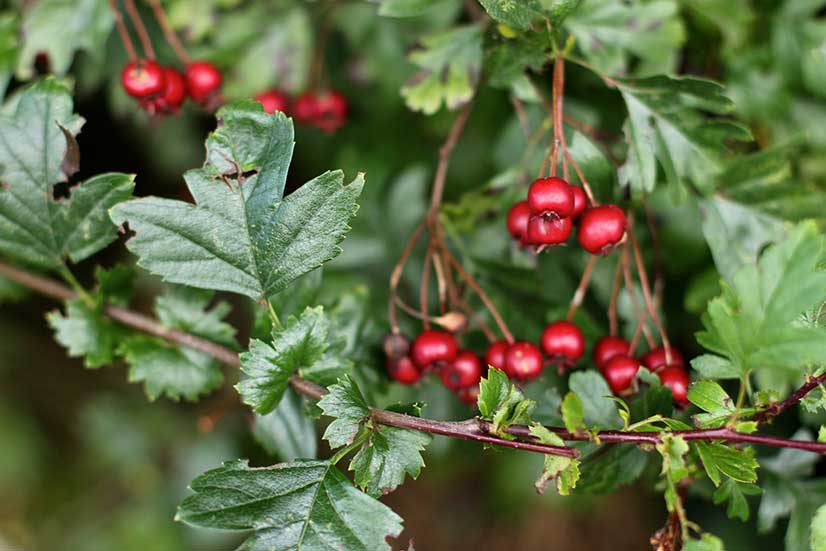
Types of Hawthorn
Hawthorn is a tree in the rose family that grows all over the Northern Hemisphere. There are more than 280 species, and herbalists use them all similarly. The species most studied in science have been Crataegus monogyna, C. oxyacantha, and C. laevigata.
Medicinal Properties and Energetics of Hawthorn
Herbalist David Hoffmann says, “A tonic in the true sense, Crataegus [hawthorn] can be considered a specific remedy for most cardiovascular disease.”1 The current Western medicine paradigm for treating chronic disease relies heavily on suppressing symptoms rather than addressing the factors causing the problem. For instance, if you have seasonal allergies a practitioner might give you something to block your body’s attempt to create histamine, but practitioners often don’t give anything to modulate your immune system and prevent the allergy symptoms in the first place. This paradigm can be seen in the range of pharmaceuticals that Western medicine uses to address the symptoms of heart disease. While this Band-Aid attempt can save lives in the short term, it doesn’t address why the person has heart disease in the first place.
In fact, many commonly prescribed medications actually deplete the body of nutrients necessary for heart health. Statins, commonly prescribed to lower cholesterol, deplete the body of CQ10, an important enzyme for a healthy heart. Diuretics, commonly prescribed for high blood pressure, deplete the body of potassium. Potassium deficiency leads to an irregular heartbeat. Hawthorn, in nourishing and strengthening the heart, does something that no other pharmaceutical can lay claim to.
How does hawthorn work? Like most herbs, hawthorn works in numerous and complex ways, many of which we don’t understand yet. However, one important factor is hawthorn’s high flavonoid content. Heart disease is often related to inflammation, and regularly eating herbs and foods high in flavonoids has been shown to decrease the inflammation and oxidative stress.
For Optimizing Cholesterol
From the 1950s to fairly recently we mistakenly believed that eating foods high in cholesterol caused high levels of cholesterol. An updated perspective on high cholesterol levels is its relationship to systemic inflammation, which hawthorn, with its high flavonoid content, helps to reduce.
Research scientists have been studying hawthorn in relationship to various symptoms of heart disease for decades. In one study researchers gave people with diabetes and coronary heart disease 1,200 mg of hawthorn leaf and flower every day for six months. After that time, those taking the hawthorn showed a greater trend toward lower LDL cholesterol (“bad” cholesterol) and decreased neutrophil elastase (an enzyme that, when elevated, is related to heart disease) than those taking a placebo.2 The dose used in this study was relatively low compared with herbalist standards, and it would be interesting to see the effects of the larger doses more commonly used by herbalists.
For High Blood Pressure
For herbalists, one of the most common indications for hawthorn is high blood pressure. Some herbalists use hawthorn singly, others combine it with other herbs, and herbalists commonly suggest it alongside a healthy diet and regular exercise. After centuries of use, it remains a favorite for decreasing hypertension.
Clinical trials have supported this traditional use. In a double-blind, placebo-controlled study done in Iran, 92 men and women with mild hypertension ingested an extract of a local species of hawthorn for four months. Blood pressure was measured every month, and the results showed a significant decrease in both systolic and diastolic blood pressure after three months.3 Another study gave hawthorn to patients diagnosed with type 2 diabetes and showed that the herb reduced diastolic blood pressure.4
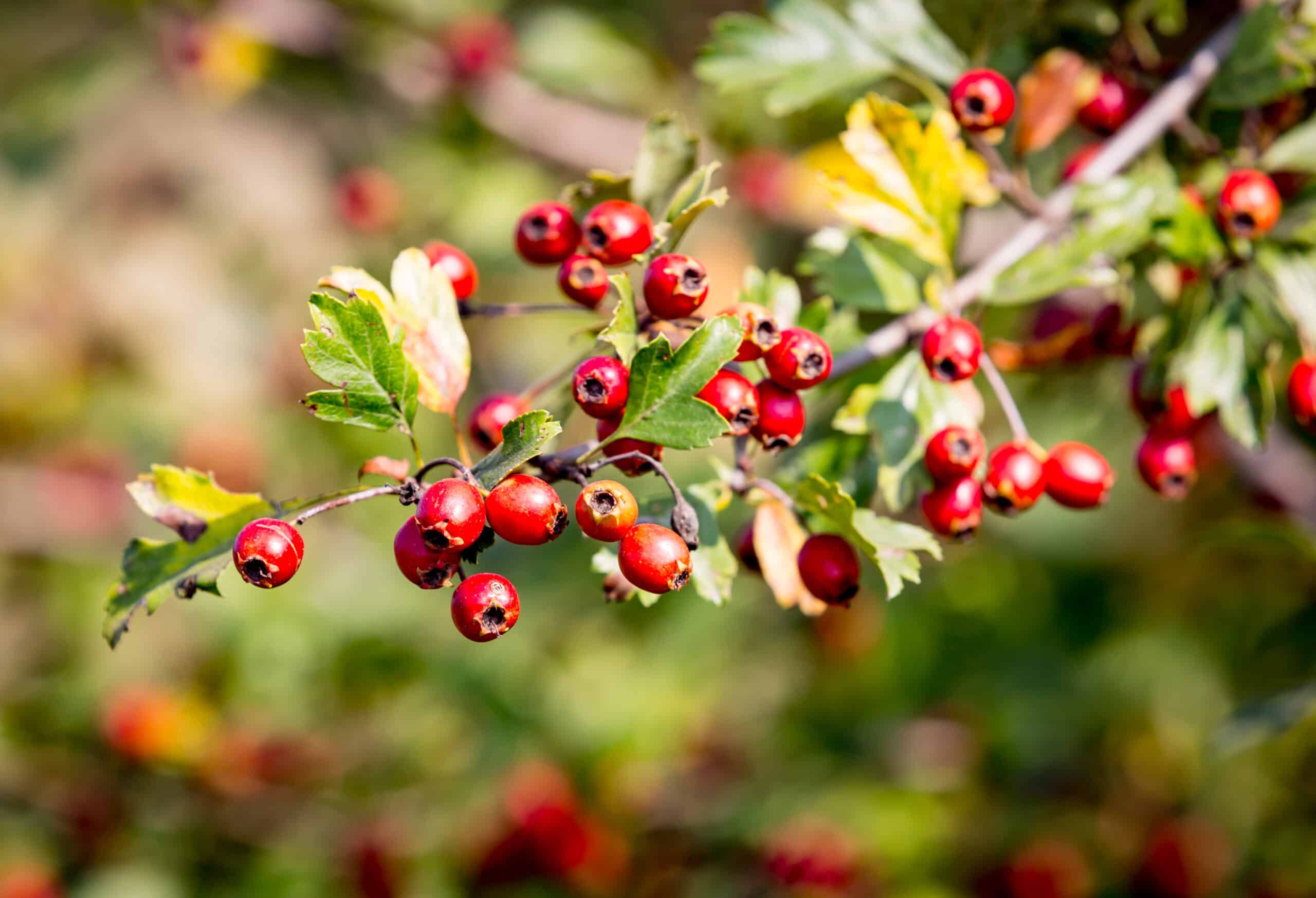
For Heart Health
Herbalist Charles Kane says, “As a heart medicine there is no other herb with such a positive, yet gentle influence than Hawthorn.”5 Besides helping to reduce particular heart problems such as high blood pressure and hyperlipidemia, hawthorn has been shown to improve general heart function in people with mild to moderate heart disease.
One study looked at 1,011 people diagnosed with stage 2 heart disease who were taking a high dose of a patented hawthorn product. After 24 weeks, researchesrs observed a significant improvement in symptoms, including decreased ankle edema, improved cardiac performance, and reduced blood pressure.6
Another trial used the same hawthorn product but studied patients for two years. After that time, those taking the hawthorn had significant improvements in the three main symptoms of heart disease—including fatigue, pain with increased exertion, and palpitations—as compared with the control group. The researchers concluded that hawthorn had a clear benefit for patients with mild to moderate heart failure.7
How to Use Hawthorn
Western herbalists tend to use the berries more frequently; however, research studies have given the flower and leaf more attention in recent years.
You can eat the berries like food and enjoy them in a variety of ways, including infusing them into alcohol or vinegar or making them into honeys, jams, or even ketchup. I recommend regularly enjoying hawthorn in large quantities; taking it daily keeps hearts nourished and strong!
The leaves and flowers make a delicious, slightly tannic tea that is reminiscent of black tea.
Recommended Amounts
Hawthorn berries are a foodlike herb that people can consume in larger amounts, as you would a food. For best results with the berries, leaves, or flowers, use it daily and long-term.
The therapeutic amount for hawthorn is as follows:
Tea: up to 30 grams of berries, and up to 30 grams of leaves and flowers, per day
Tincture (fresh berries): 1:1, 40–60% alcohol, 5 mL, 3 to 5 times per day
Tincture (dried leaf and flowers): 1:5, 30% alcohol, 5 mL, 3 times per day
Special Considerations
- People taking heart medications such as digitalis and beta blockers should consult with an experienced practitioner before taking hawthorn.
- Large dosages of the leaf and flower may cause stomach upset in some individuals. If this happens, decrease the amount.
- Hawthorn should not be used with people who have diastolic congestive heart failure.8
Hawthorn Cordial Recipe
This hawthorn cordial recipe combines the nourishing qualities of hawthorn with delicious spices that help digestion. Enjoy in small amounts after an evening meal. (I find that it helps me wind down from the day.)
I recently brought this to a potluck and served 1 to 3 teaspoons of the cordial in approximately 1 cup of sparkling water for a low-alcohol cocktail. It was a hit, and several people asked to buy a bottle from me (I gave them the recipe instead).
What you’ll need…
- 1 cup dried hawthorn berries (80 grams)
- 1 apple, chopped, seeds removed
- zest of 1 lemon
- 1 teaspoon minced fresh ginger
- 3 cardamom pods, crushed
- 1 vanilla bean, cut in half lengthwise
- 1 cinnamon stick
- 2 tablespoons dried hibiscus
- 1/3 cup unsweetened 100% pomegranate juice
- 1/2 cup honey, or to taste
- 2 cups brandy
- Place all of the herbs, spices, and fruit in a 1-quart jar.
- Add the pomegranate juice and honey, then fill the jar the rest of the way with brandy (approximately 2 cups).
- Infuse this for 4 weeks, shaking often.
- Strain. This can be stored in a dark, cool location and is best consumed within 1 year.
Yield: approximately 1 1/2 cups
Hawthorn Cordial recipe from Alchemy of Herbs: Transform Everyday Ingredients into Foods and Remedies That Heal by Rosalee de la Forêt (Hay House, 2017)
Here are some frequently asked questions about cordial recipes…
What’s the difference between a cordial and a syrup?
A homemade cordial is a liqueur that has been crafted by extracting herbs, fruits, or nuts in alcohol and then sweetening and aging this extract. A simple syrup is created by extracting herbs or fruit in hot water and then combining this water with honey, sugar, or maple syrup. When making a syrup with honey, you typically combine equal cups water with equal cups honey. Syrups are typically alcohol-free, but sometimes herbalists add alcohol to their syrups to help preserve them longer.
What makes a cordial a cordial?
Cordial ingredients are what make a cordial a cordial. These simple ingredients include herbs, fruits, or nuts, spirits (like vodka or brandy), and a sweetener. Then letting the cordial briefly age also helps bring out the flavors of the cordial.
What can I combine my cordial with?
You can enjoy either a cordial or a syrup with sparkling water for a refreshing summer drink or use them as cocktail mixers in more complex drinks recipes. You can also enjoy a cordial more like a shot, and drink a little bit of it on its own.
Adding cordials to your mixed drinks is a wonderful way to find your own signature drink to share with loved ones.
What are common types of cordials?
Some of the most popular types of cordial include elderflower cordial, berry cordial (raspberry cordial, cranberry cordial, and more!), and cordials with citrus fruits.
Now we’d love to hear from you!
What are your favorite ways to use hawthorn?
Do you prefer to use the berries, leaves or flowers (or all of them?).
Let us know in the comments below.


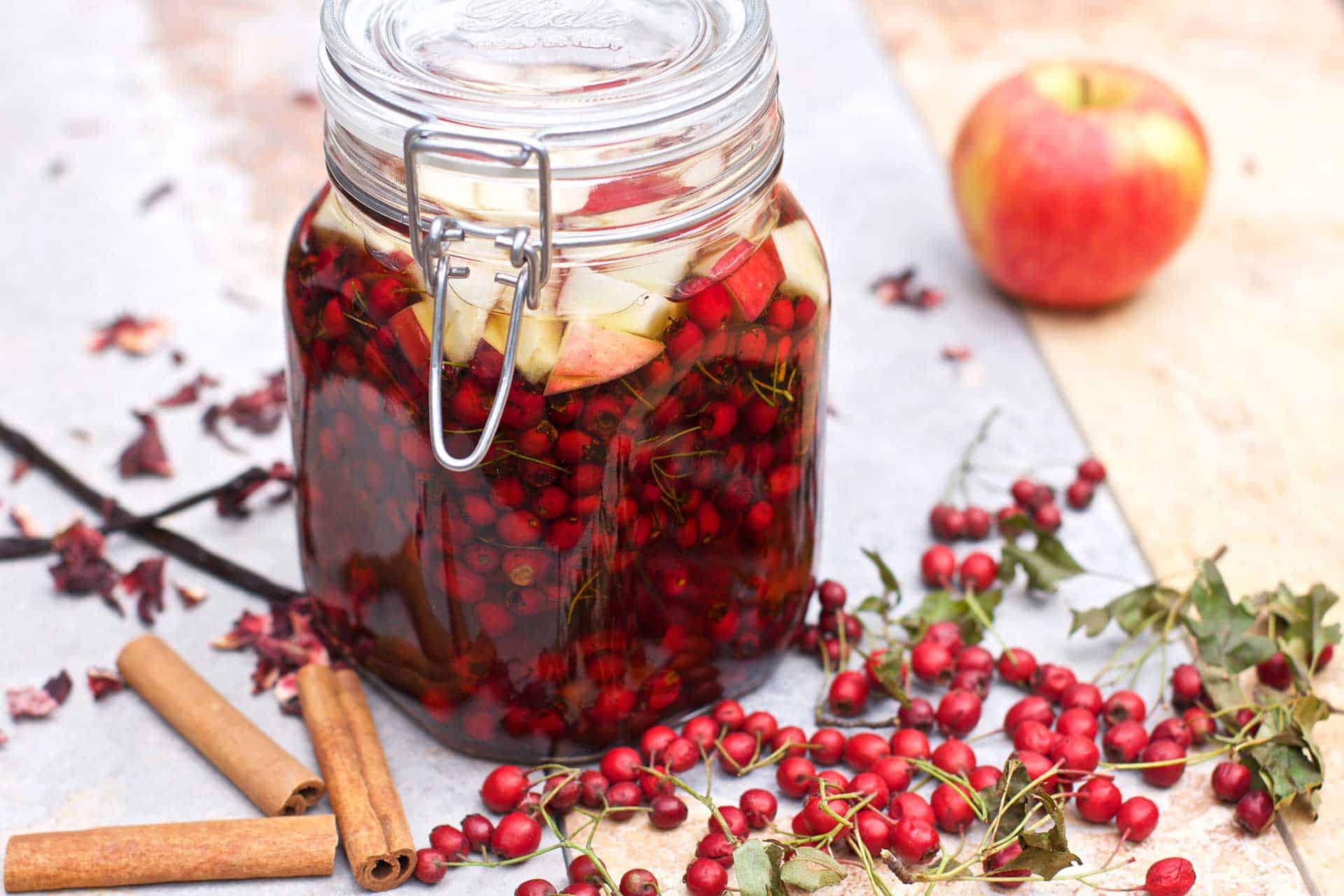
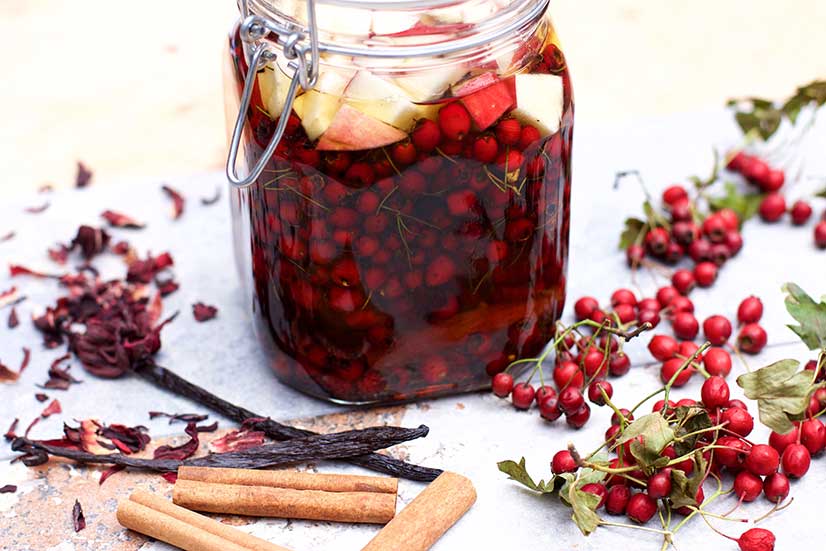
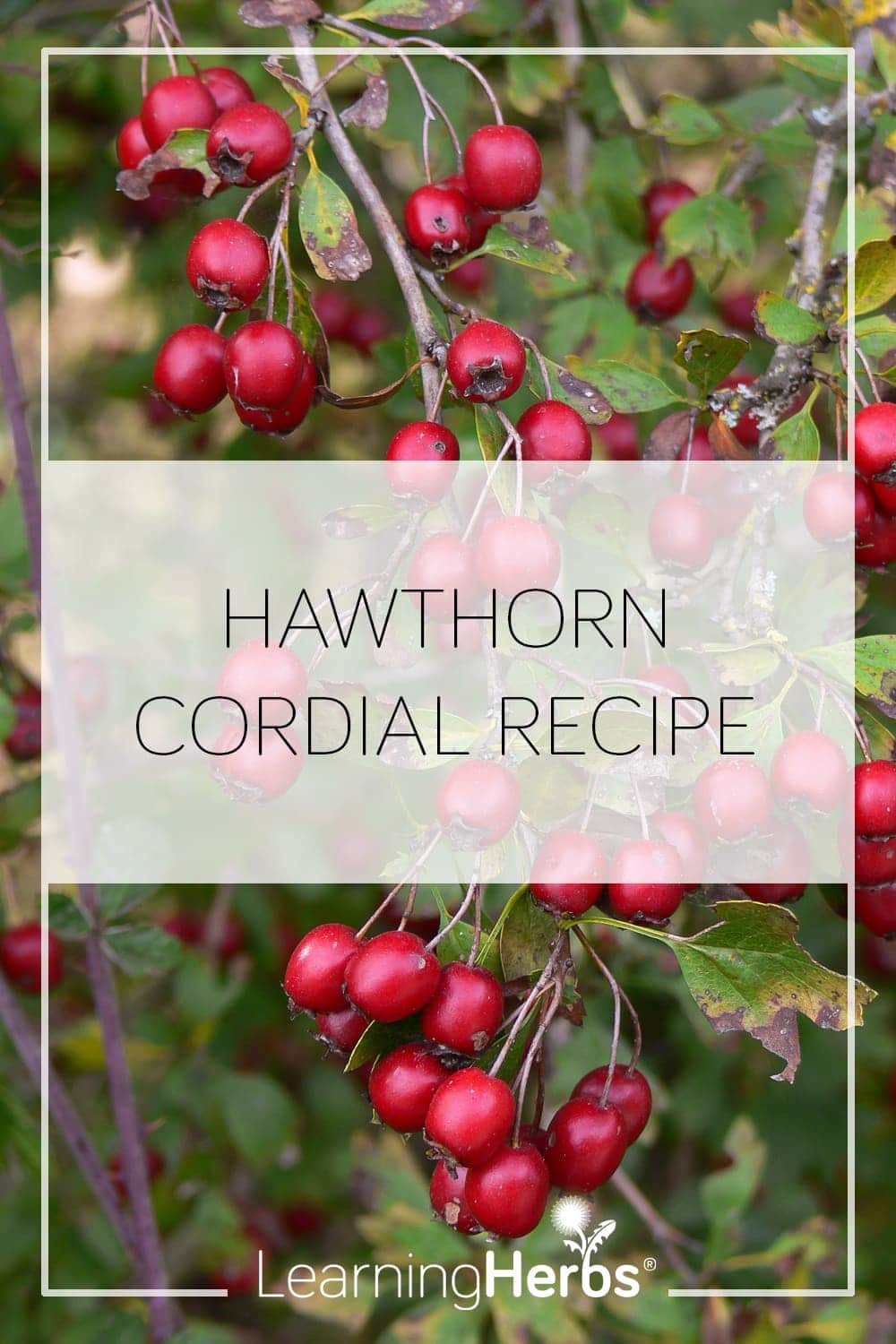

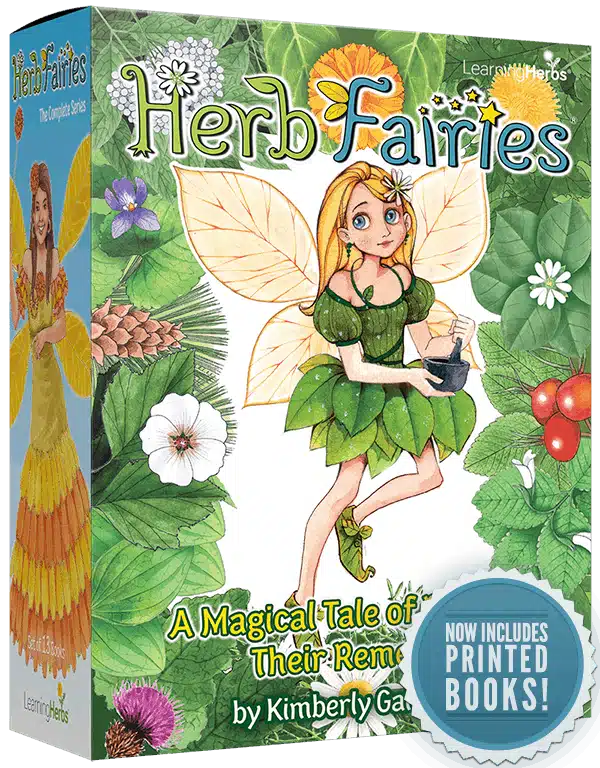





Thanks for a wonderful article! Regarding recommended amounts, what is the recipe and suggested dosage for a tincture made with dried berries? (dried leaves and flowers are included, but not berries) Thanks again!
Hello Ben,
With the folk method, you’d fill the jar with fresh berries and cover with 100 proof (50%) alcohol. Fill the jar halfway when using dried berries and everything else remains the same, including dosage.
Much love and light to you and your family through this difficult time.
Hi there. This recipe sounds delicious. I was wondering if the same recipe would work if I ground up the hawthorn berries a little bit? Hawthorn berries are very hard. Would breaking them up for this recipe improve the medicinal properties of the cordial?
I use dried hawthorn berries in the cordial recipe given and bitters recipes. I don’t grind the berries first. You could certainly try it.
Wow! Thank you for the update on Jim and for the hawthorn cordial recipe.
Is there a non-alcohol version?
You may make a tea. I’d simmer everything (except the honey and brandy) on low for 30-60 minutes to get the flavor and medicinal qualities from these ingredients.
You may also make a syrup. Simmer everything (except the honey and brandy) until the liquid is reduced by half. Strain. Add honey to taste. For longer shelf life, use equal amounts decoction (liquid after straining) and honey. Refrigerate.
Enjoy!
I will continue to pray for Jim and his family and friend’s. THANK YOU for this wonderful recipe and a place to go to if we are in need of supplies to make it! Have great day.
Hi Rosalee!
Can I use another type of alcohol in this recipe or does it have to be Brandy? I usually only have Vodka at home and sometimes spiced Rum….do any of those work?
Dina
Hello Dina!
You can certainly try a different alcohol. Although, I’d stay away from a spiced rum since it will already have flavor and properties in the rum that won’t allow the full medicinal and flavor properties of the herbs/ingredients to come though in your finished product.
Even though my hawthorn cordial is not finished infusing yet, it is quite tasty with brandy. I happen to love the energy of brandy more than other alcohols, so I always keep a bottle in my apothecary. If you have Trader Joe’s near you, they offer two brands at the VSOP quality level for good prices.
Let us know if you try it with clear rum or vodka!
All the best,
Karin
Thanks!
What a beautiful article, and perfect timing concerning our hearts ?
This will probably sound like a really dumb question, but how much do you drink and how often? I often read recipes, but don’t really understand the “average” usage to get full benefit of the medicine. Do you drink this daily? And if it makes about a cup and a half, I’m assuming you don’t drink a lot… I’m not a big drinker and a newbie with herbs…
Juli, it is understandable to have questions. The serving size is 1-3 teaspoons of the cordial in about a cup of sparkling water. It is a small amount of the cordial, like you thought. It is an ideal evening drink after dinner. Please let us know if you try it!
Should people with lower blood pressures avoid hawthorn? What would you consider too low BP?
Pat, hawthorn will help bring balance to blood pressure. Here is a quote from Rosalee on a monograph about hawthorn:
“Hawthorn is a cardiac trophorestorative, meaning it brings balance to the heart. It can be used for both high and low blood pressure and to regulate cholesterol levels.”
Please do check the Special Considerations section just above the recipe.
Can we replace the pomegranate juice with anything? I don’t have access to that here in my rural area. Thanks for any suggestions. This sounds lovely.
Pomegranates are also good for the heart and contain many health benefits. You can replace it with another healthy dark red juice, such as beet juice or tart cherry juice. All of the dark red juices will have similar components and have an affinity for the blood and heart.
You could also leave it out and use enough brandy to cover the ingredients.
Good morning Rosalee and Karin, thank you for update on your activities with jim’s family and his recovery. this recipe sounds wonderful; is the vanilla mostly for flavor or does it add to the medicine? is hawthorn more effective used like this than via quality capsules? thank you for taking time to share with us and hope to see photos of Scotland :)
Excellent questions, Meredith. After some quick research, I did find vanilla has medicinal health benefits, including protecting the heart. The article was not clear in how exactly, however.
In most cases, food-like versions of herbs (when appropriate) are considered more effective than capsule forms. It is easy to hide poor quality ingredients in capsules, and you don’t know how long the ground herb was sitting around before being encapsulated.
Let us know if you try it!
We just planted a Hawthorn Winter King tree so I am excited to try this recipe! Do I need to ensure that this particular “variety” of the Hawthorn tree is safe for consumption?
Botanical names are more useful than common names. However, here is what Rosalee wrote in the article:
Types of Hawthorn
Hawthorn is a tree in the rose family that grows all over the Northern Hemisphere. There are more than 280 species, and herbalists use them all similarly. The species most studied in science have been Crataegus monogyna, C. oxyacantha, and C. laevigata.
I just recently found out that I have Hawthorne growing in my yard (lived here for almost 17 years)!! I missed the flowers and was wondering if it is worth picking leaves still??
Thanks for the update on jim!
Glenda
In most cases, you will have berries since you did not harvest all the flowers. Exciting!!! Yes, the leaves will be useful, too. Enjoy your newfound treasure!
Are all varieties of hawthorn usable? I was looking online to buy some for my land, and it states the berries are not edible. Is this just them being unknowledgeable about hawthorn, or are there some we should not use? The variety I am referencing is Washington Hawthorn, shrub form.
Botanical names are more useful than common names. However, here is what Rosalee wrote in the article:
Types of Hawthorn
Hawthorn is a tree in the rose family that grows all over the Northern Hemisphere. There are more than 280 species, and herbalists use them all similarly. The species most studied in science have been Crataegus monogyna, C. oxyacantha, and C. laevigata.
I always mix flowers, leaf and berries.
Is it possible to make a non-alcohol version of this recipe as I do not use alcohol but would love to try making this remedy. Thank you.
Alcohol is needed to extract the medicinal qualities not gained by any other method, and it also preserves it. If you do a search on how to remove the alcohol when using it, lots of info will come up. Just using boiling hot water being the quickest. I have in the past added water boiled it all off and then added it to vegetable glycerine.
Hawthorn is one of my favourite plants. I trained as a herbalist in the UK where it literally drips from almost every field and hedgerow in swathes of glorious white in May. I have tended to tincture the flowering tops as these seemed to be higher in certain constituents when I trained (the procyanidins and other flavanoids) and make a rich red tincture and I almost always (like here) use brandy rather than vodka as it seems right for the heart. This looks a lovely tasty recipe using the berries which I may try! I use hawthorn for grief and emotional distress or ‘lack of heart’ and energetically for me it is masculine heart fire (our wild rose I perceive as more feminine heart energy in this way). Thank you